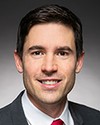The value of cars passing.... One particular pinch point would be the Skyway Bridge, which connects Burlington and Hamilton. The “Transportation Tomorrow” surveys, which are six years old, pointed at 279,000 cars moving over it in one direction. I was here a number of years ago talking about our carbon emission reduction and where we were with the biodiesel and DEF systems. It worked out that in one day we equate to 33 kilometres of cars parked bumper to bumper. Whether we go from combustion cars to electric cars, we're still going to have people backed up in gridlock. For electric cars, we know that their length of time is not where it should be. I think if you're in a combustion car, you might be on the highway longer just because you have fuel, whereas with battery you may not. That's a question to concern ourselves with whether it's combustion or electric, so I think that's a big piece.
Then you start looking at other components. If you look at something like the Ohio Valley trucking that comes through the Lewiston-Queenston Bridge, 90% of that trucking—I worked with a professor at Brock University—is destined for Ottawa and Montreal, yet it goes around the Golden Horseshoe. We need to find ways of redirecting it. They don't want to go on the toll highways through New York State to Ogdensburg—they just don't—so it's about managing that piece and, again, connecting the two biggest tourist regions in Ontario, arguably in the top three in Canada. That's a piece that we look at and understand.
If you go to an education piece—I'll step even further—the province of Ontario and the school systems averaged 179 bus trips to Toronto a week, which has stopped. The hard line used to be Stoney Creek heading to Toronto, and it used to be Oakville and Burlington heading to Niagara. Those don't happen anymore because students, parents and the education system don't want to have their kids or students in buses for four to six hours. They get a one-minute piece. I'm not here to throw anybody under the bus; that's not what I do. I want to put the energy into fixing it. The solution is not pointing fingers at it.
When it comes to government.... I was here almost six years ago. I met 67 MPs in two and a half days. I was called before Patrick Gosselin and Frank Stendardo from the bureaucratic side, policy advisers for the St. Lawrence Seaway. They grilled me on December 22 for two and a half hours. They loved it. We moved through to January 8. We were approved and moved through. It went through to the director general, Jeffrey Heynen. He said, “I love it. Let's find you buckets. We're going to put you in the NTCF.” We got an invitation to submit to the NTCF. The NTCF had five threads of payment. We were good for four of them, but we are not a port and they only paid out for a port. But I don't give up. That's a result I'm not comfortable with, and I will not give up, because this makes sense. Just as Mr. Wright is working on electric engines for his planes, and Mr. Côté on funding, we need to work on it.
A classic example of where we don't put enough thought into it would be measured around what happened at the winter Olympics, particularly the buses that they used in Whistler. They were going to use hydrogen—great—but we trucked the hydrogen in from Quebec—not great. We need to manage that end to end. We need a circular economy. We need to be ESG—environmental, social and governance—in all that we do, and end to end. We need to look at that. For example—





